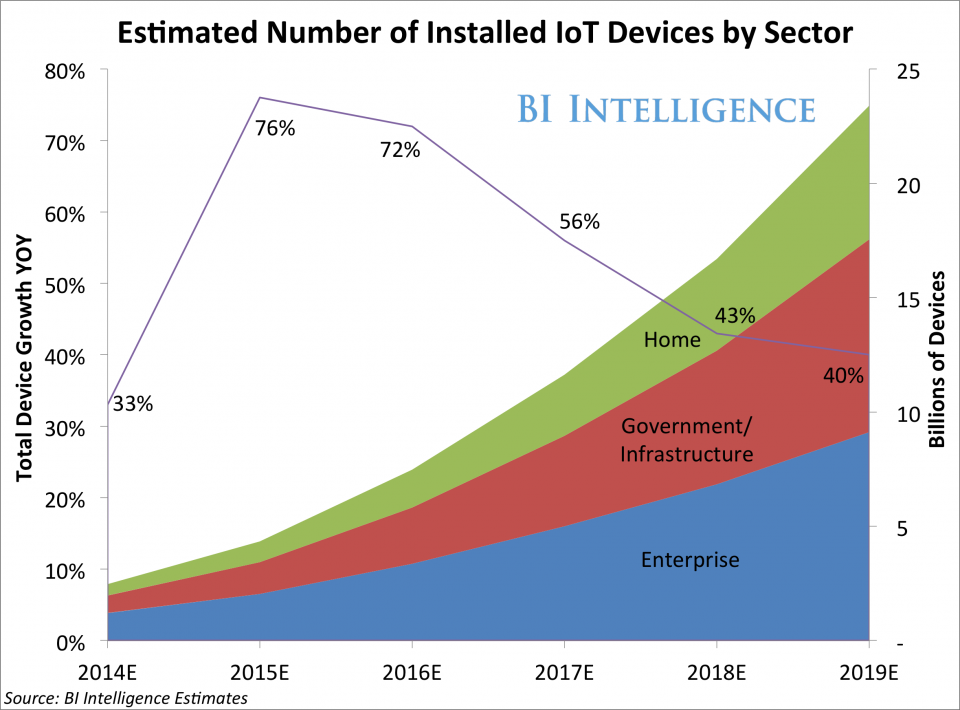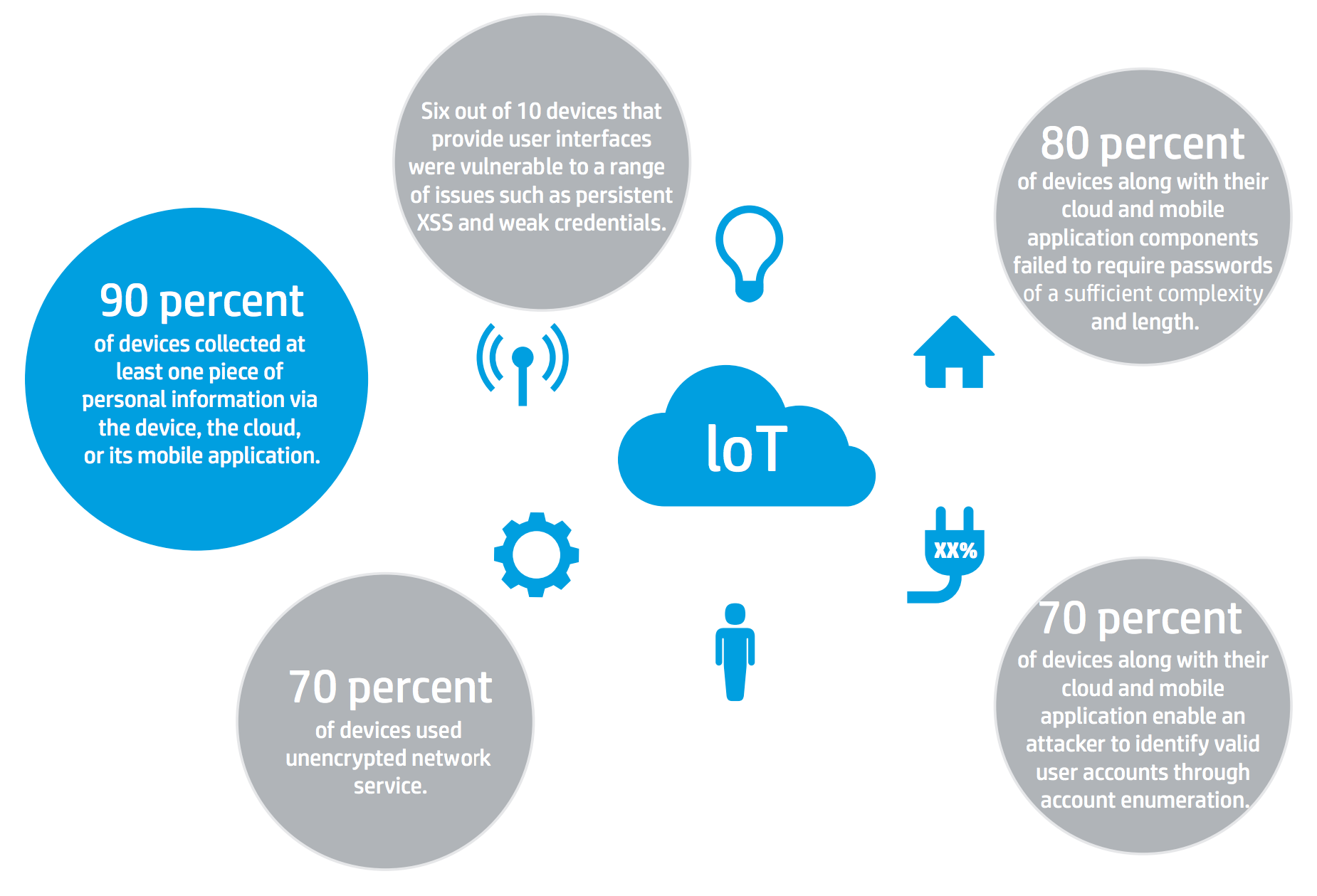Is 2015 the year Internet of Things (IoT) hype turns into opportunity? Should you invest in IoT apps and services?
If you are an independent developer, the answer is yes, but proceed with caution. The risks and are still high, but IoT app development is easy enough that you can roll out small-scale deployments with a modest investment. Creating these exploratory products now can prepare you for the larger opportunities ahead.
Yep, the market is big
A new BI Intelligence study predicts that the number of IoT devices will grow a whopping 76 percent this year. By 2019, shipments could reach nearly seven billion devices—over twice the number of smartphones, tablets, PCs, and wearables combined.

Hardware is a big market, to be sure, but BI Intelligence expects it to contribute a measly eight percent of IoT revenue. The big bucks will go to software and infrastructure.
Bottom line, the IoT is still a risky proposition. However, getting into the industry now is critical because it's entering rapid adoption. How can you take advantage of this trend?
Mobile apps vs. IoT apps
The beauty of the app economy is that independent developers can create apps with a modest investment. And the ease of distribution and monetization provided by app stores creates a strong incentive for innovators.
The IoT economy also needs independent developers, but the barriers to entry are higher. Among other challenges, IoT applications require complex hardware design, delivery of this hardware to end users, and provisioning of supporting cloud services.
This points to a three-part recipe for IoT success:
- Low-cost, easy-to-develop hardware
- Pre-built cloud platforms
- Smart IoT apps
Ingredient 1: Easy hardware
Cheap, smart IoT sensors
Sensor prices are going down 5% per year, even as sensor capabilities continue to expand. The result is smarter IoT devices that better understand their environments—at a lower cost.
To illustrate the abundance of sensors, the following are available at retail prices under $3.00:
- Rotary angle, rotary encoder, slider, two-axis joystick
- Accelerometer, gyroscope, compass
- Current, voltage, Hall effect
- Touch, physical pressure, vibration, flex
- Atmospheric pressure, temperature
- Alcohol, dust, gases
- IR proximity, UV light, distance, motion
- Water, moisture, flow
- Sound, loudness
In addition to these basic sensors, you can now get advanced sensors that incorporate some form of data processing. These sensors support a plug-and-play model that allows developers to spend more time on the IoT application. Noteworthy examples include:
- Line finder: detects lines, allowing device to move along a pre-defined path
- Heart rate: uses light beam to detect pulse, typically on a finger
- Color: detects light color and provides its red-green-blue value
- Air quality: measures particulates and harmful gases
- Sonar: uses ultrasonic sound to measure short distances
- LIDAR: longer-distance measurement by laser reflection
- Fingerprint: scans fingerprints for security purposes
- Voice recognition: recognize pre-programmed and custom commands without an Internet connection
These smart sensors are well within the reach of independent developers. For example, fingerprint sensors are available for $30.00 and voice recognition sensors for $50.00.
Commoditized IoT computers
Until recently, assembling a programmable device with advanced monitoring, processing, and communication capabilities would have cost a few hundred dollars. Today, that functionality is achievable for $30.00 to $60.00.
The steep drop in prices is a result of commoditization. This trend started with the Raspberry Pi, a low-cost platform that can run full-featured operating systems like Linux. At $35.00 each, the Pi became the benchmark for a new category of ultra-small, single-board computers. Raspberry Pi's success—5 million sold as of early 2015—spurred similar products like Intel Edison, BeagleBone Black, and LinkIt ONE.
The ensuing competition has greatly benefited IoT developers, as companies vie to produce smaller, cheaper, and faster computers. Raspberry Pi itself continues to evolve. The Raspberry Pi 2, released in February, uses a quad-core CPU and can run a version of Microsoft Windows 10, while still being priced at $35.00.
Easy IoT prototyping
Hardware design and prototyping present some of the biggest challenges for IoT development. Working with electronic components requires skills traditionally associated with a four-year degree in electronics engineering. These include:
- Ensuring compatible signaling between electronic components
- Designing for reliability, possibly under harsh conditions like heat and vibration
- Understanding the electrical parameters of sensors
- Converting electric signals from analog to digital
- Providing a clean source of power
The popular Arduino platform addresses these concerns with a pre-assembled microcontroller board that connects to sensors and actuators through standard input/output pins.
This open-source platform has been adopted by many manufacturers, who also offer extension boards called "shields," sensor modules, and development kits. A quick web search yields hundreds of Arduino-compatible hardware options—and this is just the start.
IoT production and distribution services
Of course, hardware design doesn't end at prototyping. The devices must be manufactured in volume and distributed to end users. Therefore, developers need either cheap access to manufacturing services with global logistics or easy assembly of IoT products at the local level.
For the IoT, the closest thing to a global factory is UpVerter. This service lets you specify the parts requirements, the printed circuit board design, and the desired delivery time. UpVerter will contact a manufacturing partner and facilitate the delivery of a fully-assembled board.
For local DIY production, a service such as SnapEDA can help. This company provides electronic parts and data as well as collaboration tools for electronic design. While useful, such services require a considerable degree of technical knowledge and may not meet the needs of all developers.
Ingredient 2: Easy cloud
IoT cloud services
An IoT device must be Internet-accessible. For some applications, this is a relatively simple matter of getting the device online—often through a local gateway—and connecting it to Internet clients such as smartphone apps. However, many IoT apps require data collection from numerous devices, data sharing among multiple apps and users, and analytics on all that data.
Many companies are addressing these more complex scenarios by launching IoT cloud platforms. In some cases, these platforms are free for small-scale deployments. The platforms typically handle:
- Device registration, management, security, and monitoring
- Aggregation of data from multiple IoT devices
- Big data storage and analytics
- Sharing of data with other systems and applications
- Handling and responding to device events
What's common among these IoT cloud platforms is that they offer the service on a low-cost, per-device subscription model, making it accessible even to hobbyists and the maker community.
Ingredient 3: Easy apps
Simple IoT Apps
All of these advances mean nothing without a great user experience. IoT products can be very complicated, but users don't want to deal with details. They want easy-to-use smartphone and tablet apps that improve their lives.
Good IoT apps do three key things:
- Simplify data to show what matters
- Give the user clear actions to take
- Minimize the steps required to understand and act on data
Getting these things right is critical to user adoption and financial success.
The bad news: No IoT standards
Perhaps the biggest challenge facing IoT devices is the lack of standards. There are no universal or even dominant standards for how data is exchanged among IoT applications and devices.
The same goes for the network. IoT devices typically exchange data in small chunks and need real-time, constant connectivity. Telecom networks were not designed for these requirements, so connecting to the Internet is still relatively costly. Forthcoming standards like LTE UE Category 1 will help but are not yet deployed.
Security and privacy are also big problems. IoT devices often collect sensitive information, and there's little agreement on how to protect this data. A study by HP found that 70% of IoT devices are vulnerable to attack.
Last but not least, an open, borderless marketplace for custom-built devices has yet to come out. This makes it hard to get your products in front of potential customers.
Time to join the IoT app party?
IoT is one of the most hyped areas of information technology. The high expectation may not be satisfied for years—if ever. There are still major issues that must be addressed before the IoT industry becomes the kind of opportunity that the mobile app industry is today.
Despite these challenges, now is a good time for independent developers to start exploring IoT apps. The cost and difficulty of small-scale deployments have reduced to the point that a little investment now can pay off big in the future.
Keep learning
The future is security as code. Find out how DevSecOps gets you there with TechBeacon's Guide. Plus: See the SANS DevSecOps survey report for key insights for practitioners.
Get up to speed fast on the state of app sec testing with TechBeacon's Guide. Plus: Get Gartner's 2021 Magic Quadrant for AST.
Get a handle on the app sec tools landscape with TechBeacon's Guide to Application Security Tools 2021.
Download the free The Forrester Wave for Static Application Security Testing. Plus: Learn how a SAST-DAST combo can boost your security in this Webinar.
Understand the five reasons why API security needs access management.
Learn how to build an app sec strategy for the next decade, and spend a day in the life of an application security developer.
Build a modern app sec foundation with TechBeacon's Guide.


